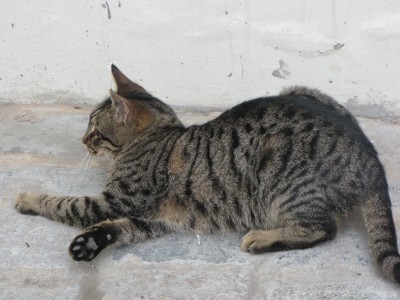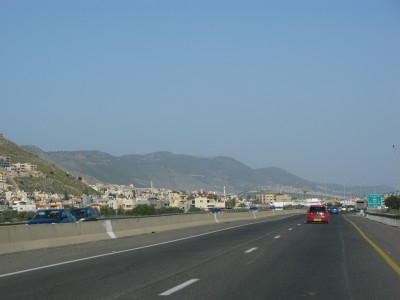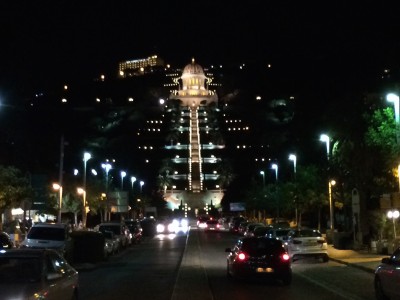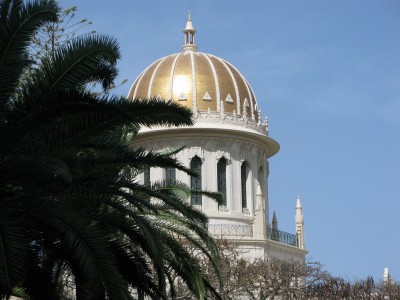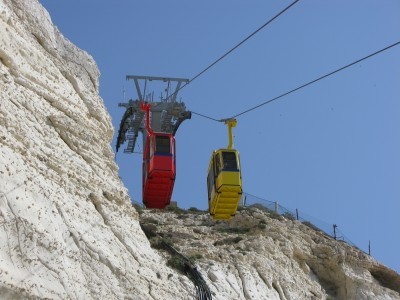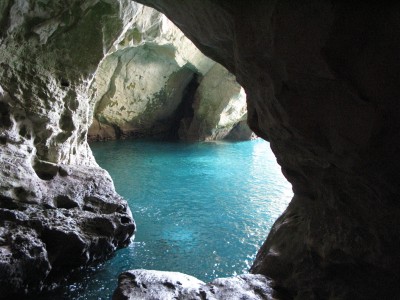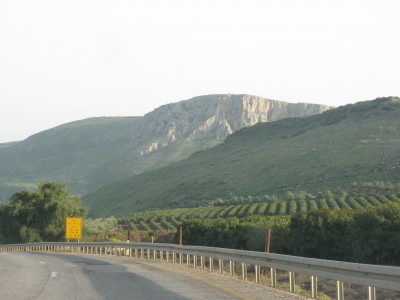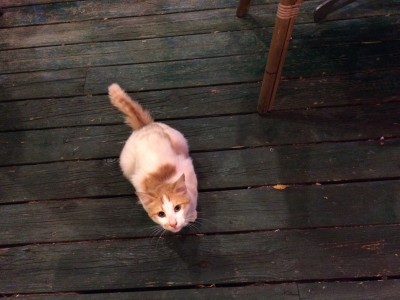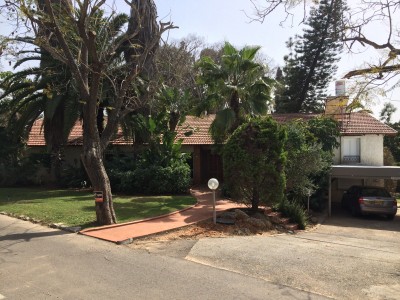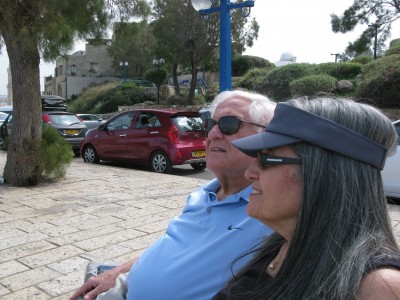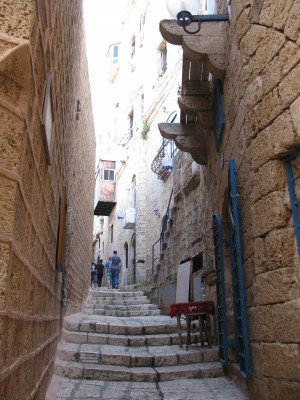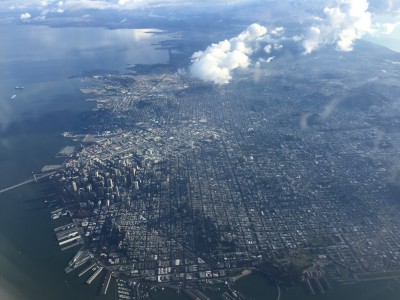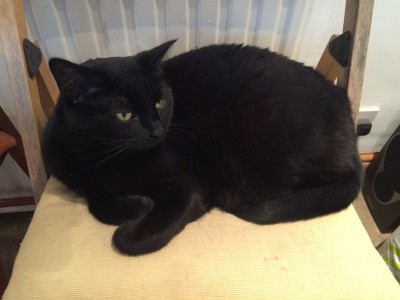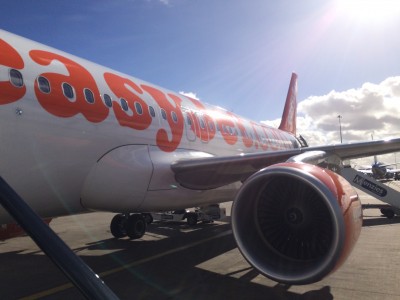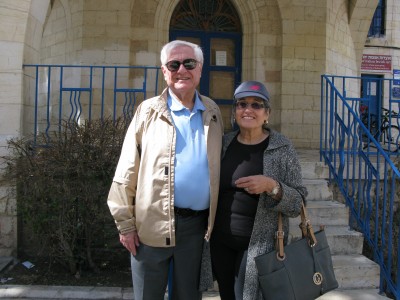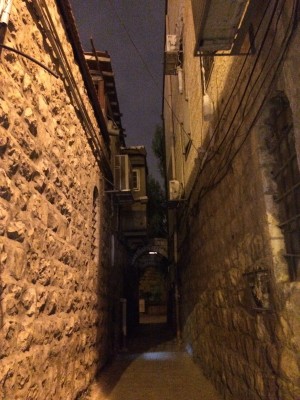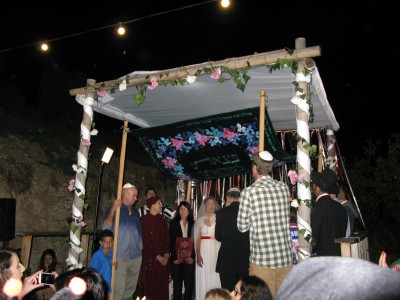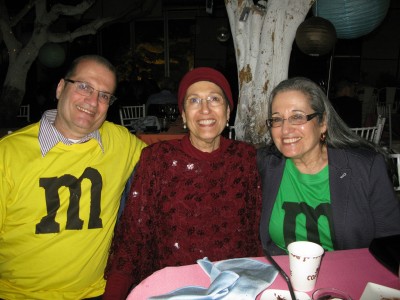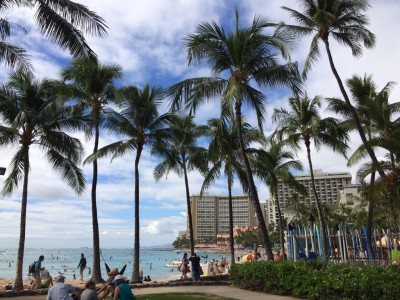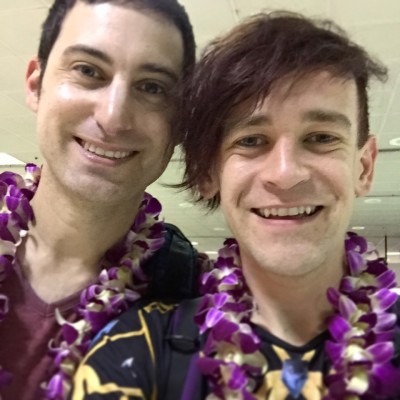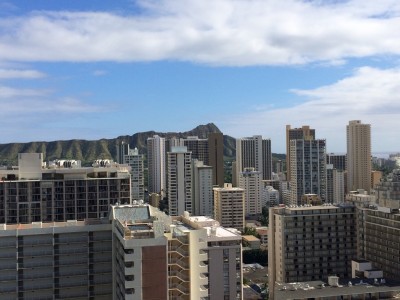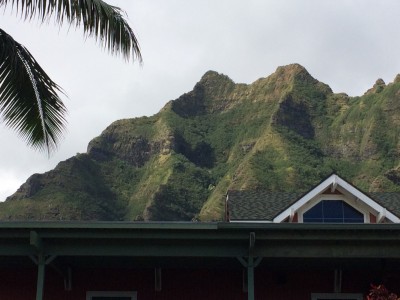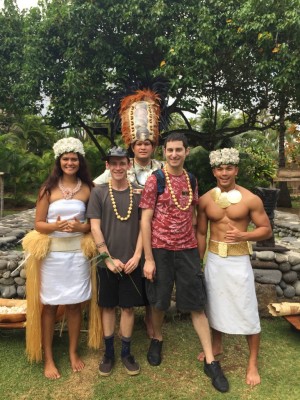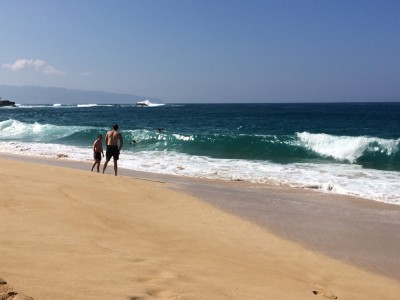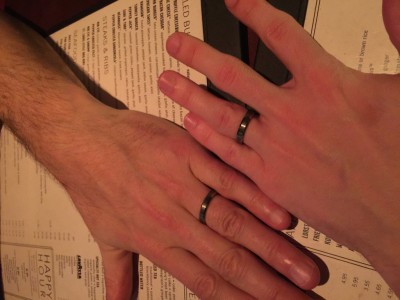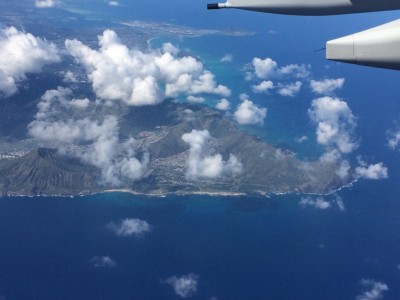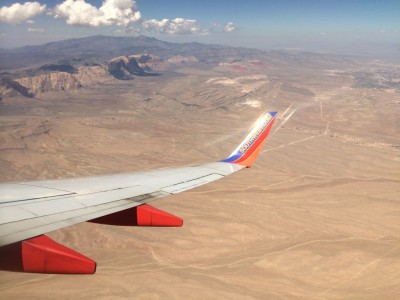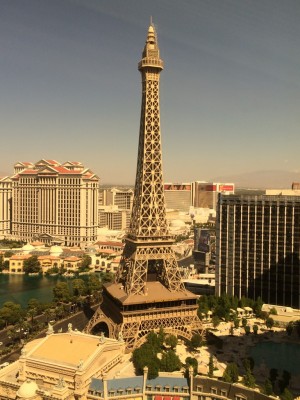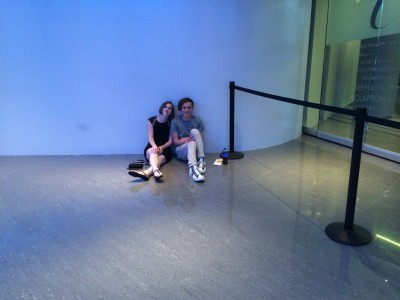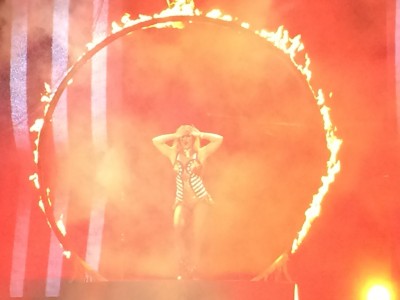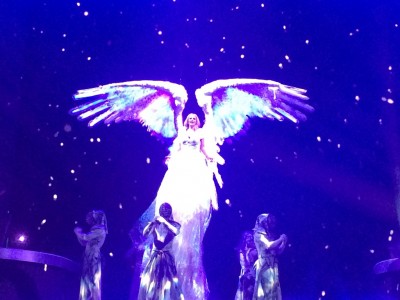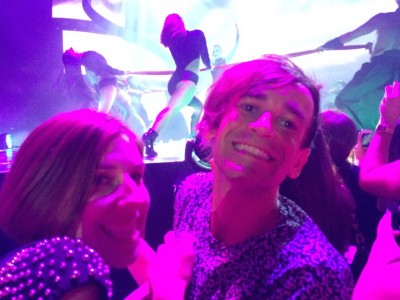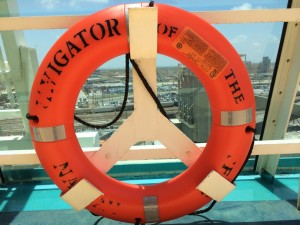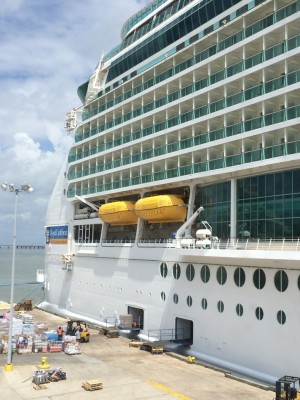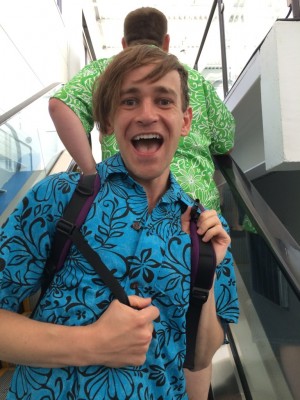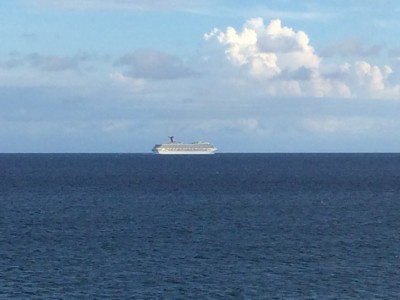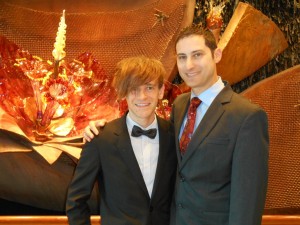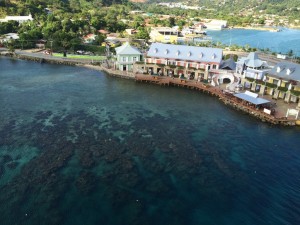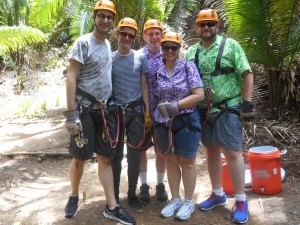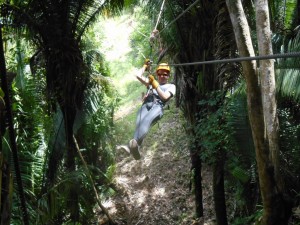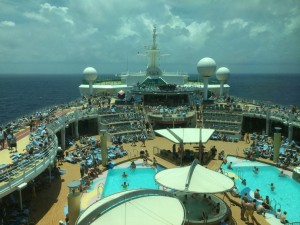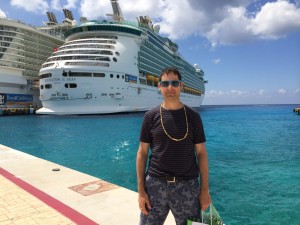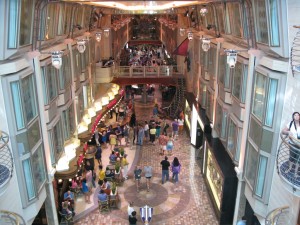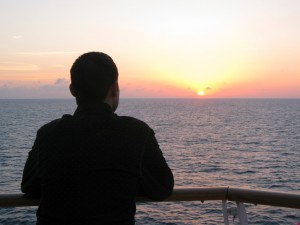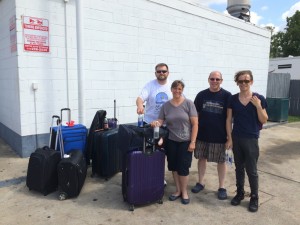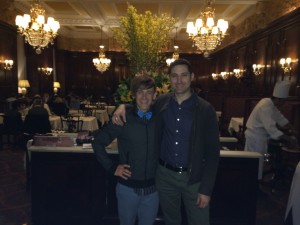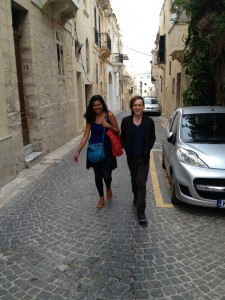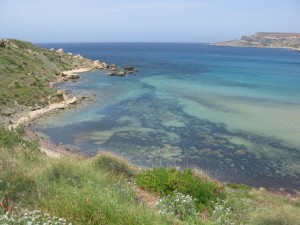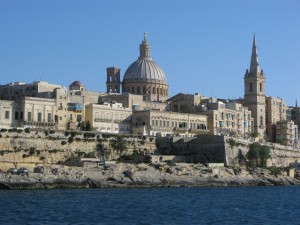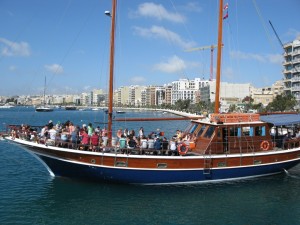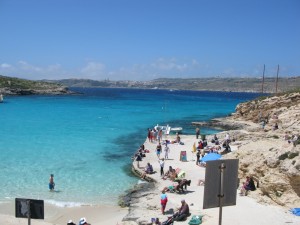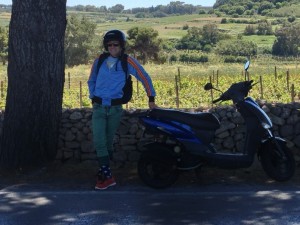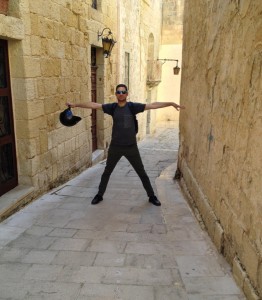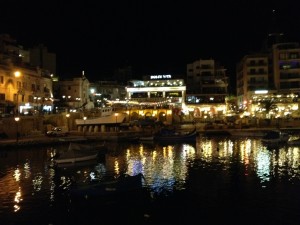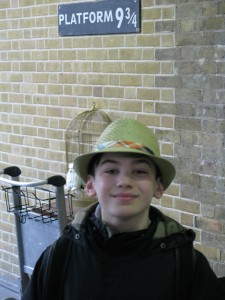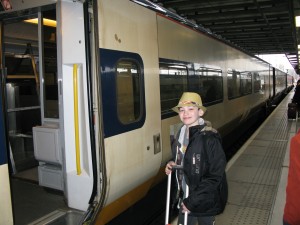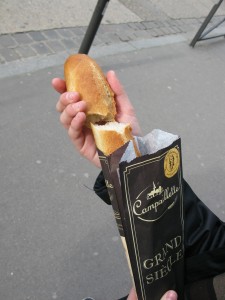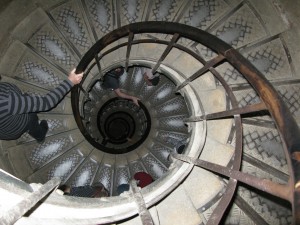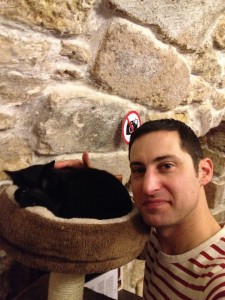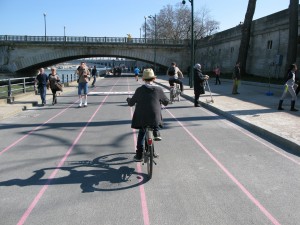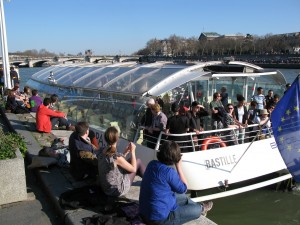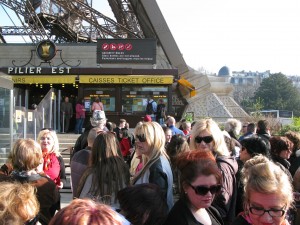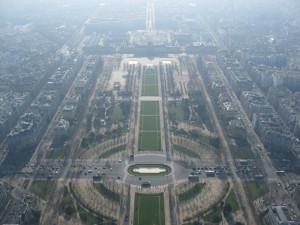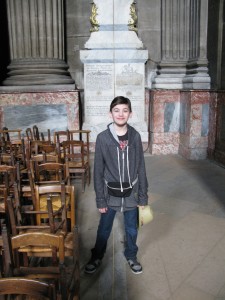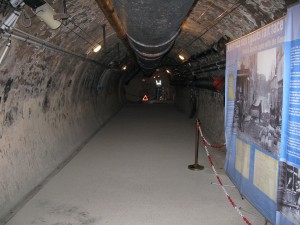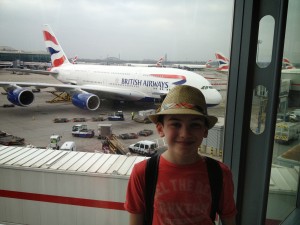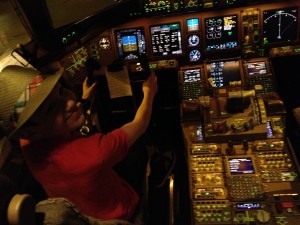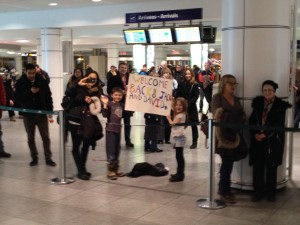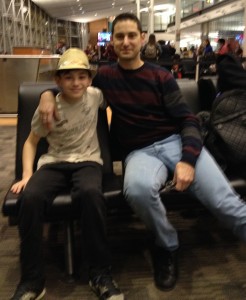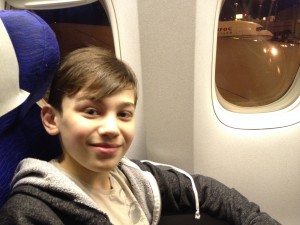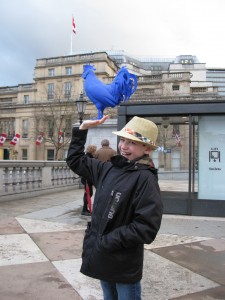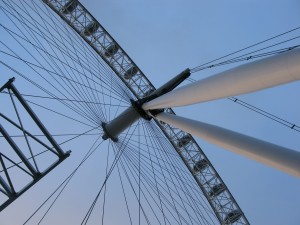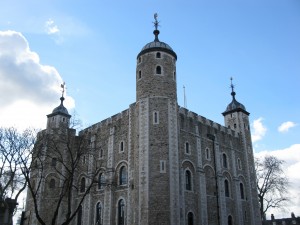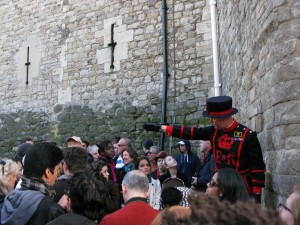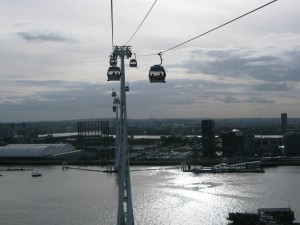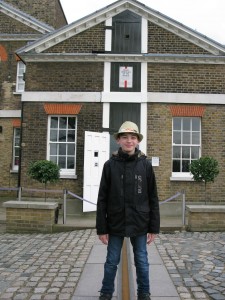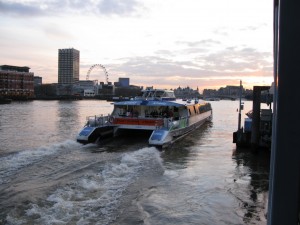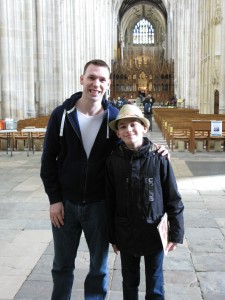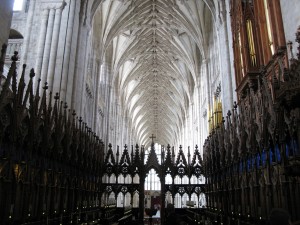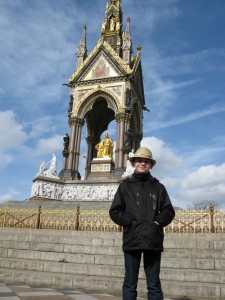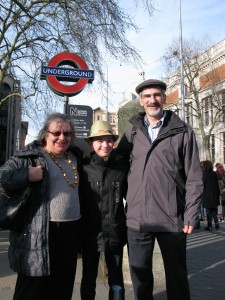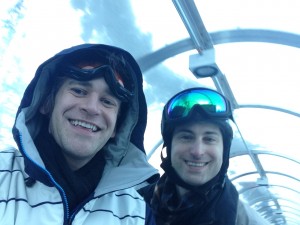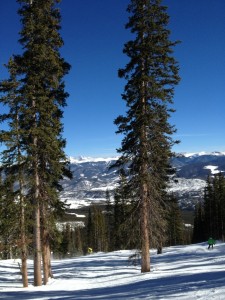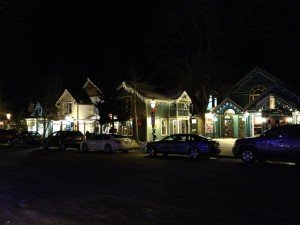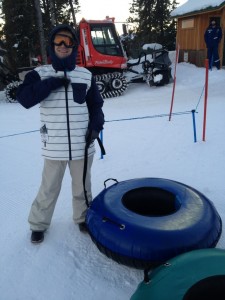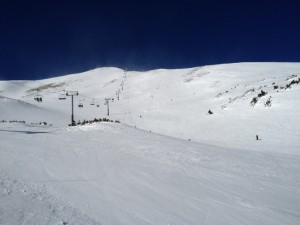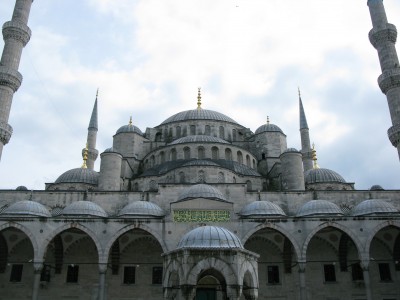 I used to hate it that my birthday fell in the middle of March: it’s not really winter, it’s not really spring, and everybody’s in the middle of everything. Heck, I was even born midweek, on a Thursday (same day it fell this year). Perhaps that’s why, beginning with my big world trip, I’ve been away on this date more often than I’ve been at home.
I used to hate it that my birthday fell in the middle of March: it’s not really winter, it’s not really spring, and everybody’s in the middle of everything. Heck, I was even born midweek, on a Thursday (same day it fell this year). Perhaps that’s why, beginning with my big world trip, I’ve been away on this date more often than I’ve been at home.
Appropriately enough, this year I spent it in the middle of the largest city in Europe, a place that bridges Europe and the West with Asia and the East.
If you think about it, the notion of “Europe” and “Asia” are in a sense imaginary: unlike, say, Australia or the Americas – landmasses physically separated by leagues of open ocean from their neighbors – the Eurasian landmass is one solid, relatively navigable chunk of terrain (just ask Marco Polo). Europe is really just Asia’s west coast. It is we humans who have given the regions their distinctiveness – and it’s inescapable, when traveling from, say, Vienna to Amman, as I did in my past travels, to notice that you’re crossing over from one place to another very different place – even though the physical distance is about the same as from San Francisco to Chicago.
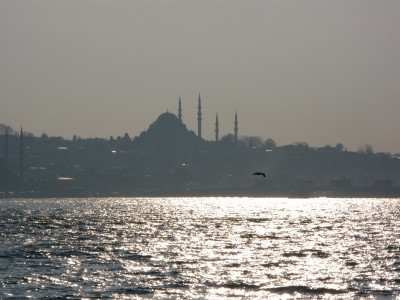 So where does the transition happen? Well, Istanbul is one of a few spots where you can kind of feel the shift take place right under your feet.
So where does the transition happen? Well, Istanbul is one of a few spots where you can kind of feel the shift take place right under your feet.
Start with climate and geography: sprawling across the narrow Bosphorus strait between the Black Sea and the Sea of Marmara (an inlet of the Aegean, itself an inlet of the Med), the city sports microclimates that rival California’s. Continue with history and politics: once it was Byzantium, an ancient Greek settlement; then it became Constantinople, capital of the Eastern Roman Empire; then, as of the 1400s, it became Istanbul, an Ottoman Muslim imperial center and, ultimately, capital of a modern nation-state.
Given this mishmash of cultures and locales, I wasn’t sure what to expect: I’d heard rave reviews about the place from numerous visitors and expats… but was also aware of some growing hostility in Islamic Turkey toward the West. Having traveled a fair bit on both sides of the two worlds this city bridges, I wondered: would it be another Cairo or another London?
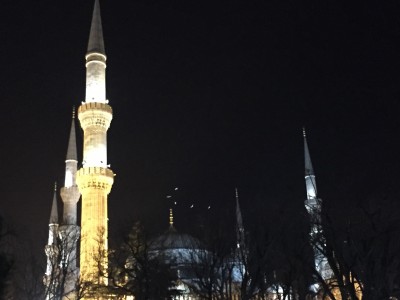 Arrival, fortunately, was as smooth and efficient as in the latter: for only the second time in all my years of travel, my luggage arrived first off the conveyor. Following the signs to the Metro, I handily purchased a fare card and boarded the train bound for the city. Transferring to the light-rail was equally a cinch. The trains were crowded, as I’d been warned, but nothing out of the ordinary for an urbanite such as myself. Alighting at historic Sultanahmet, I saw the domes and minarets of the Blue Mosque gloriously lit up in the chilly night. I wandered down tidy, narrow streets to my accommodations, an adorable boutique inn with congenial staff, a large room… and a price tag easily a third less than anything I’d paid back in Israel.
Arrival, fortunately, was as smooth and efficient as in the latter: for only the second time in all my years of travel, my luggage arrived first off the conveyor. Following the signs to the Metro, I handily purchased a fare card and boarded the train bound for the city. Transferring to the light-rail was equally a cinch. The trains were crowded, as I’d been warned, but nothing out of the ordinary for an urbanite such as myself. Alighting at historic Sultanahmet, I saw the domes and minarets of the Blue Mosque gloriously lit up in the chilly night. I wandered down tidy, narrow streets to my accommodations, an adorable boutique inn with congenial staff, a large room… and a price tag easily a third less than anything I’d paid back in Israel.
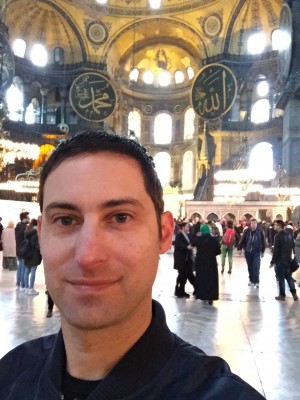 I was set to work remotely for the following two days, but that didn’t stop me from engaging in a little bit of reconnoitering: I walked through the old city to Istanbul’s star attraction, the Hagia Sophia. This massive religious structure dates back to the 6th century, a time when most of the West was in the maw of the Dark Ages following the collapse of the old Roman Empire. Its long, multifaceted heritage has seen it serve as cathedral (the largest in Europe for a thousand years), then mosque (after the Ottomans took it over), and now a museum. Predictably crowded with tourists, it was nonetheless a mammoth, bewitching old place perfect for a moody morning in the city.
I was set to work remotely for the following two days, but that didn’t stop me from engaging in a little bit of reconnoitering: I walked through the old city to Istanbul’s star attraction, the Hagia Sophia. This massive religious structure dates back to the 6th century, a time when most of the West was in the maw of the Dark Ages following the collapse of the old Roman Empire. Its long, multifaceted heritage has seen it serve as cathedral (the largest in Europe for a thousand years), then mosque (after the Ottomans took it over), and now a museum. Predictably crowded with tourists, it was nonetheless a mammoth, bewitching old place perfect for a moody morning in the city.
Meanwhile, I felt like I was being followed in my travels: Like Israel, Istanbul is also thick with street cats. I’m told they’re more respected here than back in the Holy Land. They’re all over city gardens and monuments; one even elected to preside over the crowds inside the Hagia Sophia itself, no doubt assuming that it was the subject of worship and adulation.
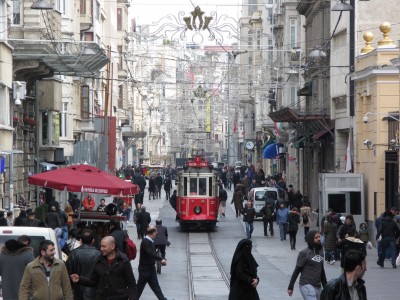 Next morning, I hopped the light rail across the bridge over the Golden Horn to the “new” city – Beyoğlu district. Truth be told, the “old” city area of Sultanahmet took me a bit by (pleasant) surprise: instead of a filthy warren of narrow street as in Islamic Cairo or Old Delhi, the ancient part of this town is tidy, upscale, and (of course) rather touristy – periodically overfriendly touts reminded me that this place is as much Asia as it is Europe. Crossing the bridge intoBeyoğlu, however, was more the Istanbul I expected: narrow, hilly streets crowded with shops and apartments. A mix of tourists and locals were out and about as I strolled down pedestrianized İstiklal Avenue, past the clanging historic tram to the broad plaza of Taksim Square. I passed Galata Tower on the way – a bona fide medieval edifice literally towering over the city’s 19th century downtown – but didn’t make it to the top due to a crowd of noisy schoolchildren. Istanbul, in this regard more like a developing world city than a European one, has grown immensely in recent decades; it’s likewise become one of the world’s top tourist destinations, and in spite of European-style infrastructure improvements, the place nonethless groans with capacity.
Next morning, I hopped the light rail across the bridge over the Golden Horn to the “new” city – Beyoğlu district. Truth be told, the “old” city area of Sultanahmet took me a bit by (pleasant) surprise: instead of a filthy warren of narrow street as in Islamic Cairo or Old Delhi, the ancient part of this town is tidy, upscale, and (of course) rather touristy – periodically overfriendly touts reminded me that this place is as much Asia as it is Europe. Crossing the bridge intoBeyoğlu, however, was more the Istanbul I expected: narrow, hilly streets crowded with shops and apartments. A mix of tourists and locals were out and about as I strolled down pedestrianized İstiklal Avenue, past the clanging historic tram to the broad plaza of Taksim Square. I passed Galata Tower on the way – a bona fide medieval edifice literally towering over the city’s 19th century downtown – but didn’t make it to the top due to a crowd of noisy schoolchildren. Istanbul, in this regard more like a developing world city than a European one, has grown immensely in recent decades; it’s likewise become one of the world’s top tourist destinations, and in spite of European-style infrastructure improvements, the place nonethless groans with capacity.
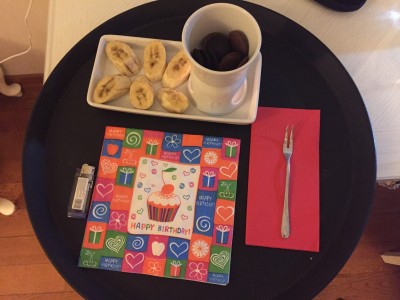 While the rest of my day was spent working, my hotel decided on a birthday surprise: they knocked on my door that evening, and presented me with a darling present of chocolate fondue with bananas – how, in a land of desserts I’m not terribly fond of they managed to figure out my absolute favorite treat in the whole wide world I’ll never know… but my already positive impression of the place went up a couple dozen notches.
While the rest of my day was spent working, my hotel decided on a birthday surprise: they knocked on my door that evening, and presented me with a darling present of chocolate fondue with bananas – how, in a land of desserts I’m not terribly fond of they managed to figure out my absolute favorite treat in the whole wide world I’ll never know… but my already positive impression of the place went up a couple dozen notches.
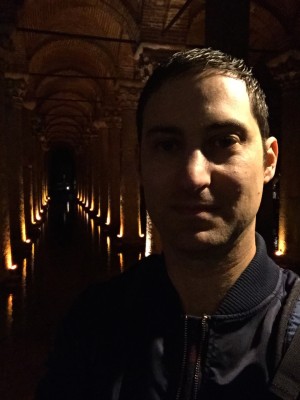 With work complete,the next morning, a bit of Bond: that scene in From Russia With Love, where 007 and his local fixer take a boat under the city to get to the Russian Consulate is in fact the Basilica Cistern (and nowhere near the real-life Consulate, but heck, it made for a great scene). Largest of many scattered through this ancient city (this one claims a pedigree going back to the 6th century and Emperor Justinian I), nowadays it’s all touristed up, replete with fish swimming in its waters and a café at the edge of its murky depths. Still, the setting is sufficiently spooky and Bond-ish… if you can forget about the (real-life) Russians hungrily snapping photos of those Medusa columns.
With work complete,the next morning, a bit of Bond: that scene in From Russia With Love, where 007 and his local fixer take a boat under the city to get to the Russian Consulate is in fact the Basilica Cistern (and nowhere near the real-life Consulate, but heck, it made for a great scene). Largest of many scattered through this ancient city (this one claims a pedigree going back to the 6th century and Emperor Justinian I), nowadays it’s all touristed up, replete with fish swimming in its waters and a café at the edge of its murky depths. Still, the setting is sufficiently spooky and Bond-ish… if you can forget about the (real-life) Russians hungrily snapping photos of those Medusa columns.
From there, I strolled through pedestrian shopping streets, to the granddaddy mercantile palace of them all: the Grand Bazaar.
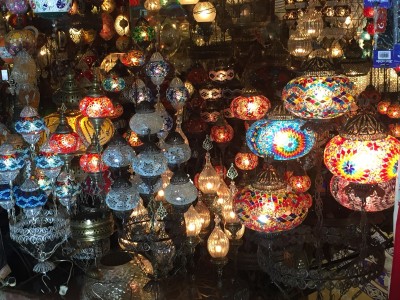 I may not be big on shopping, but this attraction – ranked among the city’s, and indeed the world’s, biggest draws – has been a must-see for me for some time. It’s a sublime place indeed, an early Ottoman take on the mega-mall dating back more than five centuries. Happily, unlike some such places in the Middle East, shopkeepers are content to leave you alone while browsing their wares. I guess Istanbul tilts more European on that score – though I did see some haggling between the odd hijab-clad lady and proprietors of the shops.
I may not be big on shopping, but this attraction – ranked among the city’s, and indeed the world’s, biggest draws – has been a must-see for me for some time. It’s a sublime place indeed, an early Ottoman take on the mega-mall dating back more than five centuries. Happily, unlike some such places in the Middle East, shopkeepers are content to leave you alone while browsing their wares. I guess Istanbul tilts more European on that score – though I did see some haggling between the odd hijab-clad lady and proprietors of the shops.
I wanted to hop on a tram to see more sights… but emerged from the bazaar to find the tram’s passage blocked by protest marchers. It all looked peaceful, though I did spot clusters of police officers in riot gear on some side streets; apparently it was all commemorating some police brutality a year back. Nothing serious came of it… but it was a reminder that Ferguson, Missouri isn’t alone on the world stage.
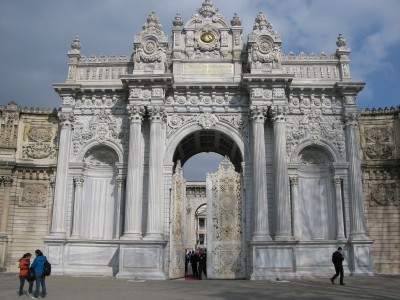 Finally reaching Kabataş on the other side of the Golden Horn, I headed to another of the city’s star attractions. Apparently, by the 19th century the Ottoman Sultans had grown tired of their old digs in Sultanahmet, and commissioned another, grander place to be built to compete with the ornate insanities of Europe. Dolmabahçe Palace was the result, a compound on the banks of the Bosphorus so grand and ornate it apparently contributed to the Empire’s insolvency and its reputation as the “sick man of Europe.”
Finally reaching Kabataş on the other side of the Golden Horn, I headed to another of the city’s star attractions. Apparently, by the 19th century the Ottoman Sultans had grown tired of their old digs in Sultanahmet, and commissioned another, grander place to be built to compete with the ornate insanities of Europe. Dolmabahçe Palace was the result, a compound on the banks of the Bosphorus so grand and ornate it apparently contributed to the Empire’s insolvency and its reputation as the “sick man of Europe.”
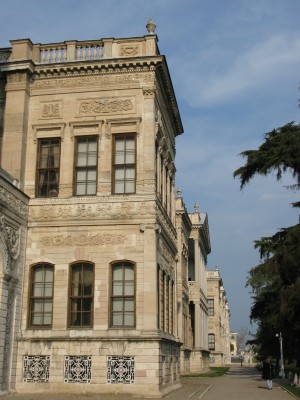 Well, I could see why: a short guided tour walked us up staircases with crystal-hewn balustrades; gold-leafed imperial reception chambers; and – just as I was wondering what they blew the Imperial treasury on – a mind-blowing, enormous Grand Ceremonial Hall to rival anything I’d seen in Paris or Saint Petersburg. Perhaps, though, the fate of the reigning monarchs of those last two fiefdoms should have given the Ottomans pause.
Well, I could see why: a short guided tour walked us up staircases with crystal-hewn balustrades; gold-leafed imperial reception chambers; and – just as I was wondering what they blew the Imperial treasury on – a mind-blowing, enormous Grand Ceremonial Hall to rival anything I’d seen in Paris or Saint Petersburg. Perhaps, though, the fate of the reigning monarchs of those last two fiefdoms should have given the Ottomans pause.
Strolling the gardens of Dolmabahçe and communing with its cats, I couldn’t help but gaze upon the famed waterway on which it sits and think: I need to cross it. It’s not every day one can cross from one continent to another in mere minutes. Fortunately, the Kabataş ferry terminal was just a short walk away, and ships to the Asian side’s popular Kadıköy district departed every half hour. Together with a mix of locals and other visitors, I boarded the tidy ferryboat and traversed the legendary waters. It was a splendid, cool, sunny springtime day as we passed some industrial bits of harbor and arrived on the other side.
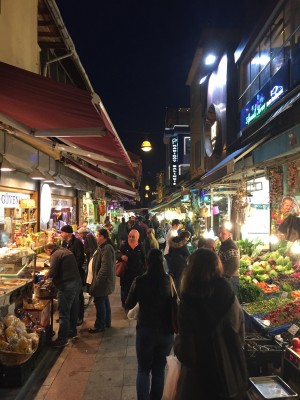 Kadıköy was fantastic – every bit as busy and bustling as shopping districts on the other side, but significantly less touristy. Yet another warren of pedestrian streets revealed a busy fish market, some garment shops lining a narrow alleyway, and gaggles of pubs and eateries. The waterfront offered mystical, hazy views of the mosques and minarets of Sultanahmet, just across the water. Consider this another air-bridged harbor that twin cities frame, in Emma Lazarus parlance.
Kadıköy was fantastic – every bit as busy and bustling as shopping districts on the other side, but significantly less touristy. Yet another warren of pedestrian streets revealed a busy fish market, some garment shops lining a narrow alleyway, and gaggles of pubs and eateries. The waterfront offered mystical, hazy views of the mosques and minarets of Sultanahmet, just across the water. Consider this another air-bridged harbor that twin cities frame, in Emma Lazarus parlance.
It was after dark by the time I finished my reconnoiter (and a bite of dinner), so I opted for a speedier way to cross the Bosphorus: Istanbul is in the midst of expanding its modern but hopelessly overcrowded subway system, which includes a new tunnel under the water that’s part of the Marmaray rail line. The gleaming conveyance took me back to Europe in less time than it takes BART to traverse San Francisco Bay.
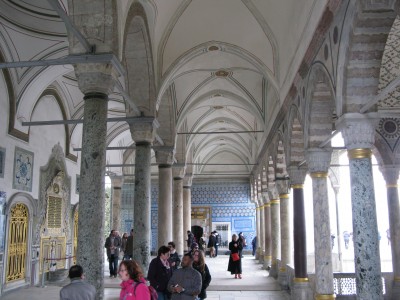 My last full day in Istanbul saw moodier weather than the rest, so I stuck closer to home and visited some spots I’d missed in previous days. Having seen the majesty of Dolmabahçe I figured I owed its predecessor a nod: I hoofed it over to Topkapi Palace, the older Ottoman-era residence commanding the tip of the Sultanahmet peninsula at Seraglio Point. Predictably, this place is a more eastern-styled affair, with arched courtyards and intricate tilework – and bigger crowds, given its proximity to other Istanbul landmarks.
My last full day in Istanbul saw moodier weather than the rest, so I stuck closer to home and visited some spots I’d missed in previous days. Having seen the majesty of Dolmabahçe I figured I owed its predecessor a nod: I hoofed it over to Topkapi Palace, the older Ottoman-era residence commanding the tip of the Sultanahmet peninsula at Seraglio Point. Predictably, this place is a more eastern-styled affair, with arched courtyards and intricate tilework – and bigger crowds, given its proximity to other Istanbul landmarks.
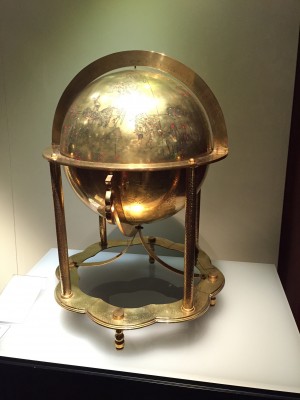 A walk through the palace’s former gardens led me to an utterly appropriate spot to spend Pi Day: the Museum of the History of Science & Technology in Islam. A short film at the start of the exhibits explains – a bit defensively, I noted – how the oft-overlooked work of Islamic scholars preserved and expanded upon scientific knowledge through the Middle Ages. In addition to carrying forward the work of the ancient Greeks, Islamic scientists expanded on areas of mathematics, as witnessed in the Arabic terms algebra and algorithm. Models and recreations of everything from water clocks to oversized astronomical instruments (the originals of which I saw in Jaipur, India) proved that cultures the world over can readily adopt the language of science if so inclined.
A walk through the palace’s former gardens led me to an utterly appropriate spot to spend Pi Day: the Museum of the History of Science & Technology in Islam. A short film at the start of the exhibits explains – a bit defensively, I noted – how the oft-overlooked work of Islamic scholars preserved and expanded upon scientific knowledge through the Middle Ages. In addition to carrying forward the work of the ancient Greeks, Islamic scientists expanded on areas of mathematics, as witnessed in the Arabic terms algebra and algorithm. Models and recreations of everything from water clocks to oversized astronomical instruments (the originals of which I saw in Jaipur, India) proved that cultures the world over can readily adopt the language of science if so inclined.
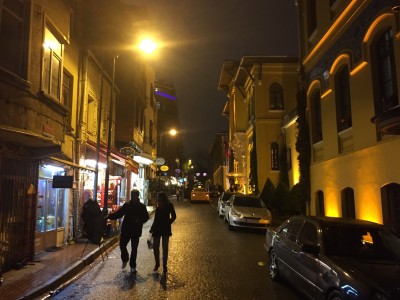 Wandering back from dinner through the streets of Sultanahmet on my last night in the city confirmed it: yes, this metropolis straddling two continents and cultures makes for an excellent place for a global nomad, born between two seasons of the year, to spend a birthday at work and at play… to say nothing of the enjoyment garnered by those glorious Turkish cats.
Wandering back from dinner through the streets of Sultanahmet on my last night in the city confirmed it: yes, this metropolis straddling two continents and cultures makes for an excellent place for a global nomad, born between two seasons of the year, to spend a birthday at work and at play… to say nothing of the enjoyment garnered by those glorious Turkish cats.

